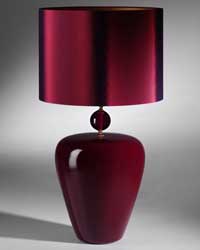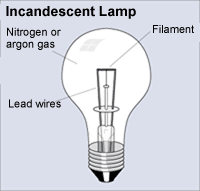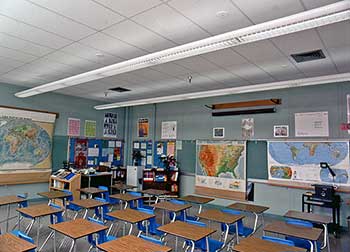Energy-Efficient Lighting
It takes a lot of energy to light up the world. Lighting is responsible for 19% of electricity use worldwide. In the United States alone, lighting accounts for almost 25% percent of electricity use in homes, and about 13% in offices, stores, schools, and other commercial buildings. Clearly, reducing the amount of energy used for lighting would make us more energy efficient. But modern society relies on electric lights so we can remain active at all hours of the day and night. What makes current lighting systems so inefficient?

Photo courtesy of C. Mayhew & R. Simmon (NASA/GSFC), NOAA/ NGDC, DMSP Digital Archive This image, actually a composite from many different images taken by Defense Meteorological Satellites Program satellites, shows the amount of human-made light at night. It is very easy to see the most populated areas, which have the most light. |
The easiest and most obvious step to save energy is to turn off lights that are not in use. While that helps, it does not solve the problem. The big question is, how can we make artificial lighting more energy efficient?
What We Currently Use
Most electric light fixtures use either incandescent or fluorescent lightbulbs, or lamps, as the light source. Incandescent lamps produce a pleasing warm light. They are relatively inexpensive to manufacture and come in all kinds of shapes and sizes. Many different types of lighting fixtures are designed to fit the screw-in base of this type of bulb.
|
Image courtesy of Light Waves Concept Track lighting hangs overhead in a room. Each head rotates and can be pointed to light up a particular section of a room. |
Photo courtesy of TeslaMall Ltd. Fixtures such as the table lamp are made to use standard incandescent light bulbs. |
Photo courtesy of U.S. Department of Energy The incandescent lamp consists of lead wires and a filament encased in a glass bulb filled with nitrogen or argon gas. Electricity heats the wires, causing the filament to glow. |
The incandescent lamp consists of a large glass bulb attached to a metal base that serves as the electrical contact. The outside of the base is threaded, to be screwed into the light fixture. The hollow glass bulb contains a metal wire called a filament—the filament is made of tungsten—attached to the electrical contacts in the base of the bulb. The filament is very long—about 2 m (6.5 ft) in a standard bulb—but extremely thin, at about 0.254 mm (0.01 in). The wire is very tightly coiled and that coil is then wound again, to fit inside the bulb. An inert gas such as argon fills the inside of the bulb. When an electrical current runs through the filament, it heats up and glows.
|
Fluorescent light fixtures have long been used in offices, stores, and classrooms. The light is cool and bright, and does not produce a lot of extra hear. |
There are a number of drawbacks to incandescent lamps. The tungsten evaporates over time of use, weakening the filament until it breaks. At that point the lamp no longer works and needs to be replaced. A 100-watt incandescent lamp is rated to last 750 hours, not a very long time. However, the biggest issue for incandescent lamps is that they are not very energy efficient: they produce heat as well as light. This heat escapes into the surrounding environment. In fact, incandescents produce the least light for the amount of energy used to power them. This makes them huge wasters of energy.
The halogen lamp is another type of incandescent light bulb. Halogen lamps also use a tungsten filament, but a hollow quartz covering (quartz is much harder than glass) filled with halogen gas encloses the filament. When the filament heats up, the halogen gas reacts with tungsten vapor, redepositing tungsten atoms back on the filament. This enables the filament to last much longer, and to be heated to a hotter temperature. Thus a halogen lamp lasts longer than a standard incandescent and gives off light that is brighter and purer in color. However, halogen lamps get extremely hot, much more so than standard incandescent lamps. That means that halogen lamps are also energy wasters.
Fluorescent lamps, the other common type of electric lightbulb, are much more efficient than incandescent lamps. Fluorescents use approximately 30% of the energy of an incandescent bulb to produce the same amount of light. They are commonly found in institutional settings: schools, offices, stores, and public buildings. Lighting fixtures that use fluorescent lamps are cheaper to operate, and they produce a fair amount of light for the money.
Compact Fluorescent Lightbulbs
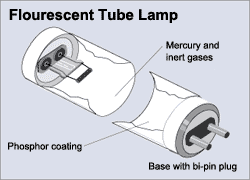
Photo courtesy of Michigan Country Lines The compact fluorescent bulb uses the same process as a traditional fluorescent tube, but uses a smaller spiral shape and a screw-in base that allows it to fit into fixtures made for incandescent bulbs. |
The compact fluorescent lightbulb (CFL) is one very popular option for reducing lighting costs. The CFL is a fluorescent lamp manufactured to fit the same fixtures as incandescent bulbs. This type of lamp has been available since the early 1980s but is only now catching on with consumers. The big advantage: CFLs use much less electricity—70% to 75% less, according to some sources.
CFLs have the same energy-saving advantages of standard fluorescent lamps. But only now are these lamps being used regularly. Why? The early CFLs were terrible. The light they produced was dim and dull, with an awful color. On top of that the lamps took a long time to reach full power, and even at full power, they flickered. Today’s CFLs are much better. The color has been softened, the light is no longer dim, and the lamps start up much more quickly. The improvements have resulted in greater popularity with consumers. In fact, some countries, including Australia and Canada, have mandated that consumers switch from incandescent lamps to CFLs by specific dates. Other countries are also encouraging consumers to make the switch to save energy.
CFLs are not perfect replacements for incandescent lamps. Many consumers do not like the light these lamps produce, despite the vast improvements in the last few years. And the lamps still take some time to warm up to full power. Like their long-tube predecessors, CFLs contain a very small amount, usually 4 to 5 mg (0.00014 to 0.00018 oz), of mercury, a toxin. If the lamp breaks the mercury enters the general environment. A portion of that mercury evaporates, but so little enters the environment that researchers believe it poses little or no danger. Proper cleanup and disposal of the broken lamp takes care of the rest of the mercury.
Light-Emitting Diodes
Another promising approach is the use of light-emitting diodes (LEDs) for interior lighting. LEDs are commonly used already for many things, such as digital clocks and the lights on light-up wristwatches. But now these little lights are being used in lamps, to replace incandescent bulbs for interior lighting.

Photo courtesy of Crane The LED bulb is the newest type of lower-energy lamp projected to replace incandescent bulbs. Made from durable plastic, an LED bulb uses the movement of energy in a semiconductor material to create light. |
LEDs use a different technology from incandescent and fluorescent lamps. Instead of relying on a filament that gets used up or electrodes with a limited number of starts, LEDs produce light by the movement of electrons in a semiconductor, a material or compound that allows some flow of electricity. Electricity is sent to a diode made of a semiconducting material, causing the electrons to increase in energy level. As the electrons drop back down to normal levels, they release photons, or light energy. The color of the light depends on the material used in the diode. A silicon diode produces infrared light, but other materials produce different colors in the spectrum. In addition, the semiconductor material used for the diode must be one that does not absorb the photons, but releases them outward, to produce light. The light coming from the diode goes every which way, but the lamp has a plastic cover, which concentrates the light. Individual diodes are not bright. Thus they are grouped together in lamps, to produce the desired amount of light for the bulb.
LED lamps have many advantages over other types of lighting. They are made of durable plastic, not more-breakable glass. LED lamps do not burn out the same way as lamps that use filaments. The diode does degrade, producing less light after thousands of hours of use. But the bulbs are long-lasting, with a lifetime between 50,000 and 100,000 hours until the degradation of light becomes noticeable. The small size of LEDs fits modern electronics. Most important, LEDs are energy efficient. Much more of the energy is used to create light and not wasted heat.
LEDs are not without disadvantages. Until very recently they were prohibitively expensive, reflecting the cost of the semiconductor material. The material price has started dropping, but the lamps remain significantly more expensive than traditional lamps. For example, in 2009 a standard incandescent bulb was around US$0.75 per bulb, while a replacement LED bulb was US$45. The longer life of the LED balances out some of the expense.
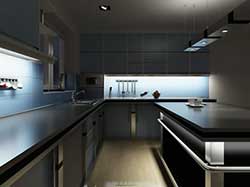
Photo courtesy of Belfer Group LED bulbs produce light that does not focus as well as other bulbs, and is best used for general light, rather than spot lighting. |
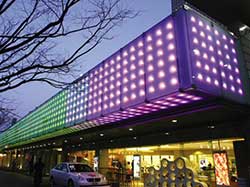
Photo courtesy of LEDs Magazine Colored LED lights are used to create a distinct look for modern buildings like this one in Seoul, South Korea. |
|||
The quality of light given off by LED lamps poses a more significant problem. The light tends to be diffuse—it does not focus well for spot lighting. Color also remains an issue. LED lamps produce excellent shades of red, green, blue, purple, pink, and a very bright white. Because of this, LEDs are increasingly being used for dramatic and colorful interior and exterior architectural lighting, including holiday lights. However, LED technology thus far has not been able to produce a light similar to daylight. The very harsh light of a white LED makes colors look odd. Researchers continue to work on developing an LED lamp that can produce a color similar to daylight.
Daylighting
Natural light is a very important source of energy-efficient light. Architects and builders are making more use of daylight, working with lighting designers to help place windows and skylights in new homes or commercial buildings. Modern double-paned windows can keep the cold out during the winter, although not as effectively as insulated walls, and with special coatings to reflect light, they can prevent interiors from heating up too much during hot summers.
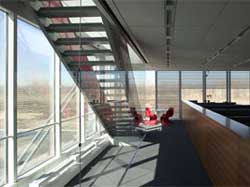
Photo courtesy of David Joseph/Lawrence Berkeley National Lab–David Joseph/The New York Times Newer buildings use natural daylight to light interior spaces as a way to save energy. |
Lighting designers help place windows in locations that will make the best use of light without burdening the building with extra heating or cooling costs. For example, north-facing windows let in even light year-round, while south-facing windows maximize light in winter; neither lets in much glare. Proper roof overhang and planting of trees can prevent extra heat coming in during in the summer in windows that receive direct sunlight. West- and east-facing windows are avoided as much as possible, because they let in light and heat, as well as glare.
Skylights also let in light without too much heat, if positioned and installed properly. The skylight must have a slope that maximizes winter heat and lessens summer heat. Installation must be done carefully, to prevent leaking during rainstorms.
Down the Road
Motion-detector lights have a sensor that switches on the light when movement occurs within the sensing field. When the motion stops, after a certain time the light switches off. Light fixtures with this feature are commonly used on building exteriors, as a way to have light only when it is needed. Installation of this type of fixture in building interiors for rooms that are not in regular use, such as storage rooms, is one way to save energy; this type of use is on the rise.
Researchers are looking at ways to make lighting even more energy efficient. One technology under development would channel the light from the Sun to the interior of buildings through “light pipes” that contain reflectors. Another technology uses fiber optics to bring in light, combining solar lighting and standard electric lights. In this project electricity takes over when sunlight decreases to a certain level. These and other technologies are all in the early stages of research.
This content has been re-published with permission from SEED. Copyright © 2025 Schlumberger Excellence in Education Development (SEED), Inc.



